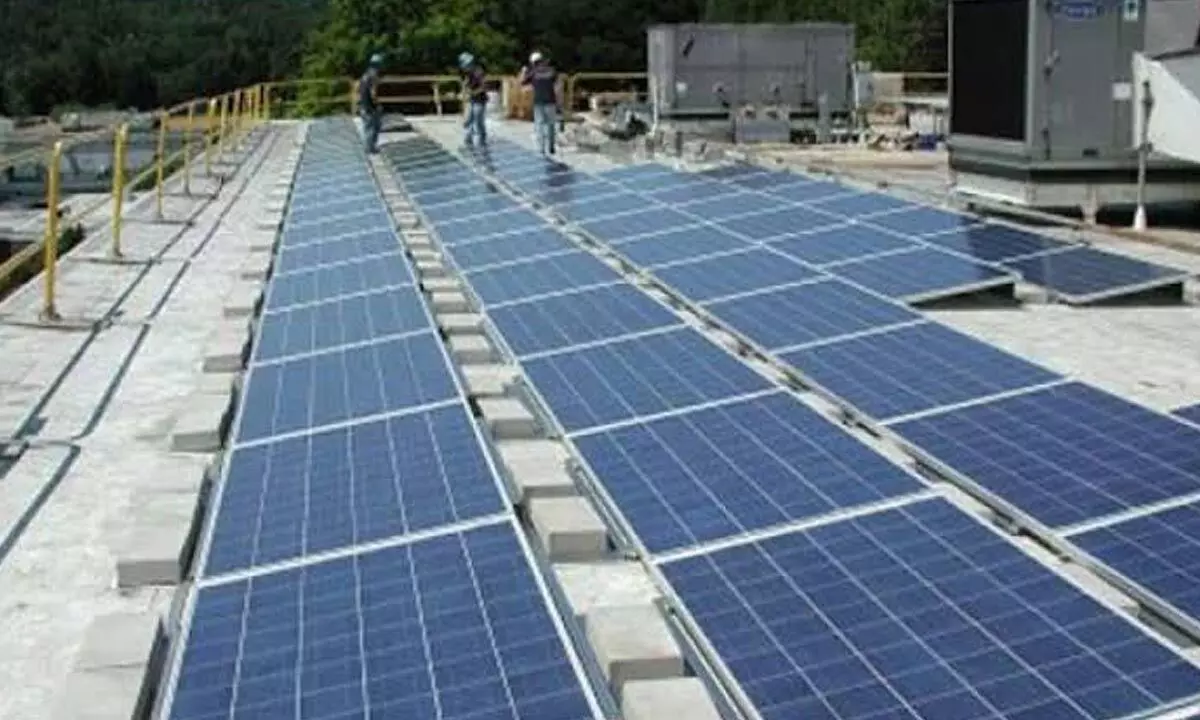Domestic solar plants, a panacea for growing burden of power bills

Rooftop solar plant on Gates Engineering College in Anantapur
- Those people and institutions, who switched on to solar power are witnessing a cut down in power bills by 60 per cent
- The JNTUA is saving massive power bills of Rs 5 lakhs by generating own power under RESCO model
Anantapur-Puttaparthi: A host of both public and private sector agencies apart from domestic housing sector are going for solar power generation, thanks to the growing burden of power bills and even disruption in power supply due to overload problems in summer. An estimated 100 mega watts of power generation is going on by individual households and educational institutions and public universities. Those people and institutions, who switched on to solar power are witnessing a cut down in power bills by 60 per cent.
While the AP Transco is selling power at Rs 10 per unit inclusive of all sorts of charges, power generated by solar plant costs them only Rs 3.64 per unit, which means a reduction in power bills by two-thirds. Renewable Energy Services Company (RESCO) is executing the project in all places where rooftops are offered for solar power generation by institutions. The JNTUA is saving massive power bills of Rs 5 lakhs by generating own power under RESCO model. The Farmers Training Institute at Tractornagar is saving Rs 40,000 power bill every month by power generated from 40 KV plant in its campus.
Sathya Sai Baba's Prashanthi Nilayam is generating 4 megawatts of solar power in its campus sprawling over hundreds of acres in the piligrim town of Puttaparthi. Kia Motors is producing 2 megawatts of solar power while Ultratech Cements 10 mws etc. Except for the initial investment which is realised in less than 5 years, the remaining 20 years which is the life span of the solar panels, it is absolutely free enjoyment of power supply sans maintenance.
The solar and wind power projects in Rayalaseema are generating more than 6,000 mw of non-conventional energy power of which Anantapur district alone is contributing to 5,000 mw of power. Efforts are being made to fast track three major upcoming solar and wind projects and ensure their completion by early 2023.
AP Power Generation Company is executing a major solar power project at a cost of Rs 3,500 crore at Talaricheruvu village in Kadiri mandal. Works are progressing on a fast pace and are expected to be completed by the end of current financial year. Another 1,500 mw of power will be produced by all the three projects combined. Once the projects are completed, Anantapur district's contribution to power production will come to more than 5,000 megawatts of solar and wind power.
Land acquisition for the 200 MW wind-cum-solar hybrid power project has been completed, according to National Renewable Energy Development Corporation (NREDCAP) district manager Kodandarama Murthy. The project coming up in Ramagiri town in the district is spread over 1,000 acres of land located in Ramagiri and Kanaganipalle mandals. Already 750 acres have been acquired in Ramagiri and another 250 acres in Kanaganapalle. The World Bank aided wind-cum-solar power hybrid power project costs Rs 1,400 crore and is being implemented by National Institute of Wind Energy (NIWE) and the SECI. The unique project is another feather in the cap of Ramagiri town, which had hosted several wind and solar power projects. The power project is likely to be completed by early 2022.
NREDCAP district manager Kodandarama Murthy told The Hans India that a 35-km line from Ramagiri to Hindupur has been laid to supply power to National Power Grid. The uniqueness of project is that the project will have 40-megawatt hour storage capacity while the total power production is 200 MW. The project promoters have already submitted environmental impact assessment. The NTPC which started off with 250 mw of producing solar power in 2018 over the years has in a phased manner expanded to 1,000 mw and currently running to its full capacity. It is the largest power production by a single agency.

















